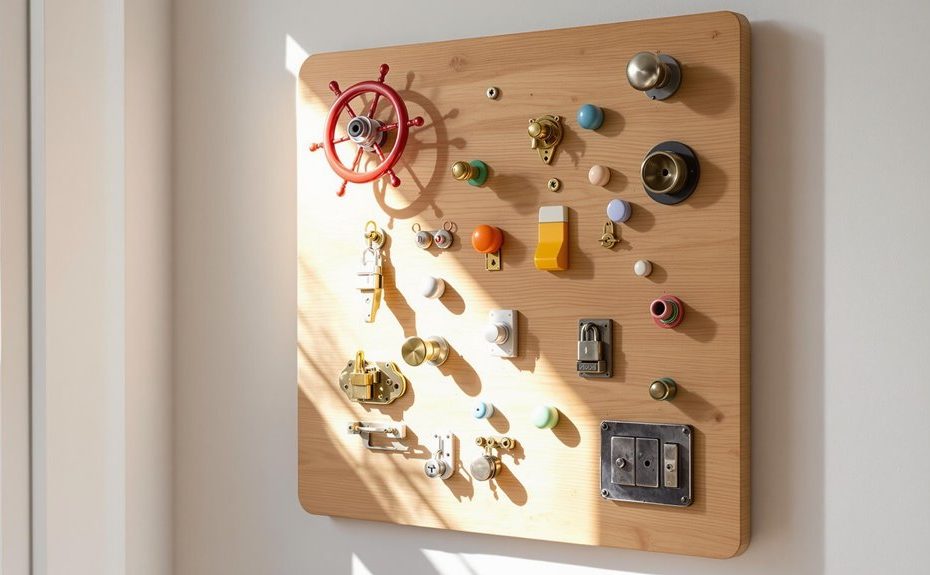Transform everyday items into engaging educational toys with these creative DIY busy board ideas. Start with basic door hardware like latches, locks, and handles for fine motor development. Add light switches with LED lights, musical elements like bells and chimes, and a transportation panel with steering wheels. Include kitchen tools, office supplies, and construction-themed items for real-world learning. Create themed sections with sports equipment, garden tools, and sensory materials like different textures and sounds. Each element offers unique learning opportunities while keeping little hands busy and minds engaged. Let’s explore these exciting possibilities for your child’s development.
Basic Door Hardware Board
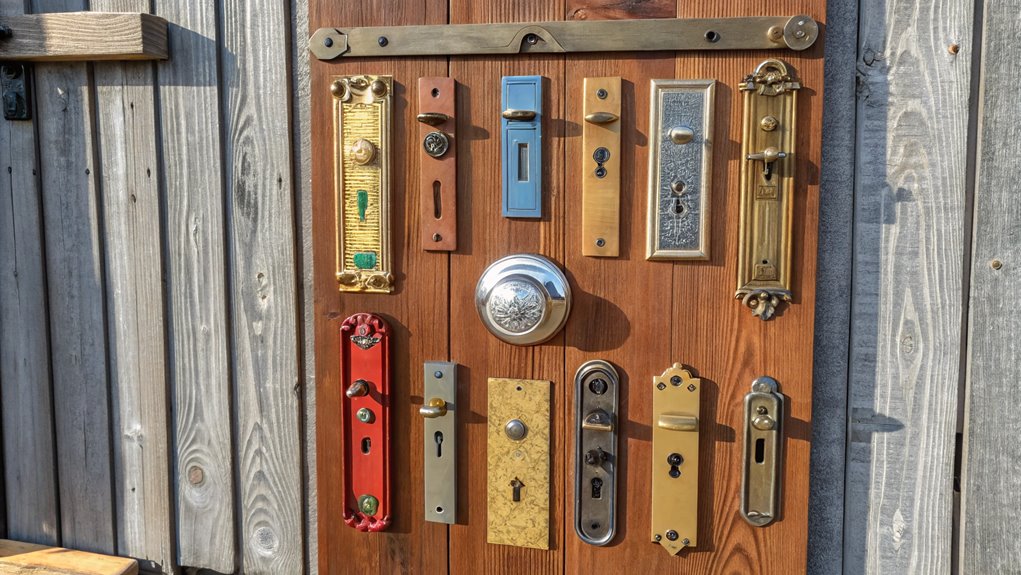
A Basic Door Hardware Board kicks off any DIY busy board collection with essential manipulative elements that toddlers encounter daily. You’ll want to include various door mechanisms like latches, locks, and handles that little ones can safely explore. Adding different hardware textures through knobs, hinges, and catches keeps them engaged while developing fine motor skills they’ll use throughout their lives.
Light Switch Learning Station
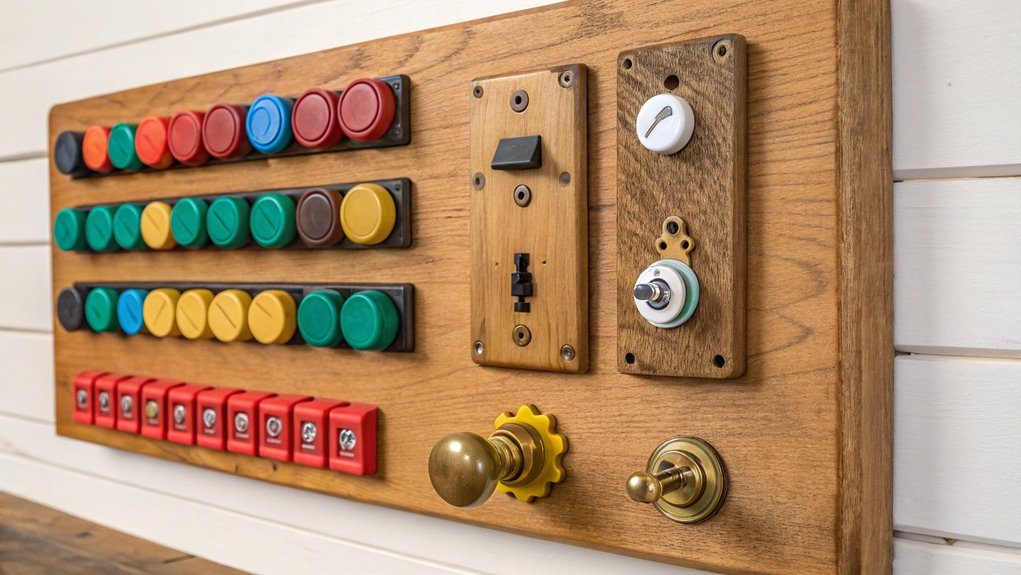
Every toddler’s fascination with light switches can be transformed into an educational experience through a dedicated light switch learning station. You can create a safe space where your little one explores different types of switches while learning light switch safety. Add LED lights, dimmers, and fun colors to spark light switch creativity. Your child will love flipping switches while developing fine motor skills.
Musical Elements Board
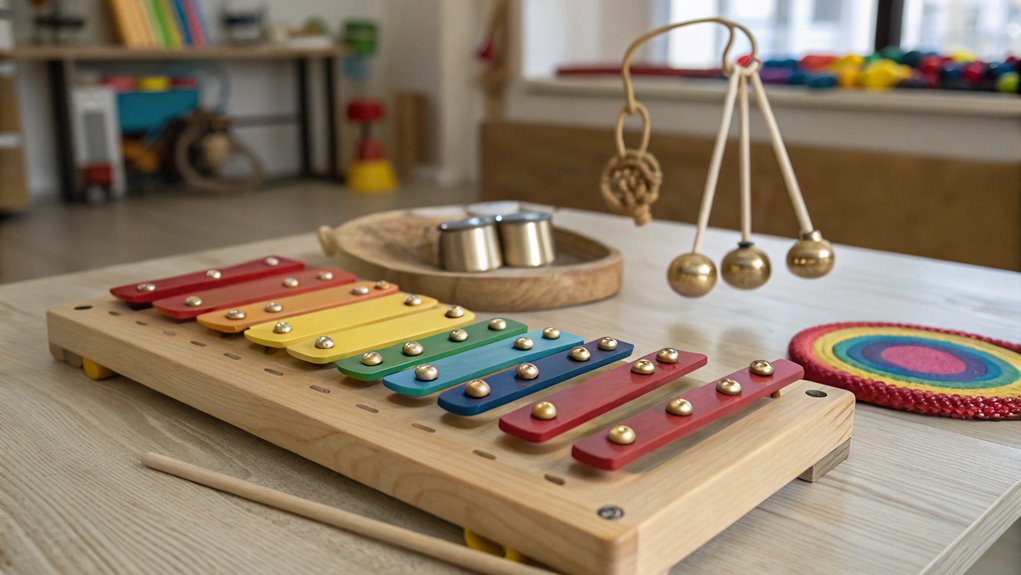
Musical elements bring sensory enrichment to any busy board through the incorporation of bells, chimes, drums, and other interactive sound-making components. You can create engaging sound rhythm activities by attaching small percussion instruments, xylophone bars, or even recycled items that make interesting noises. This musical instrument exploration encourages children to discover different sounds while developing their auditory skills and creativity.
Transportation Themed Panel
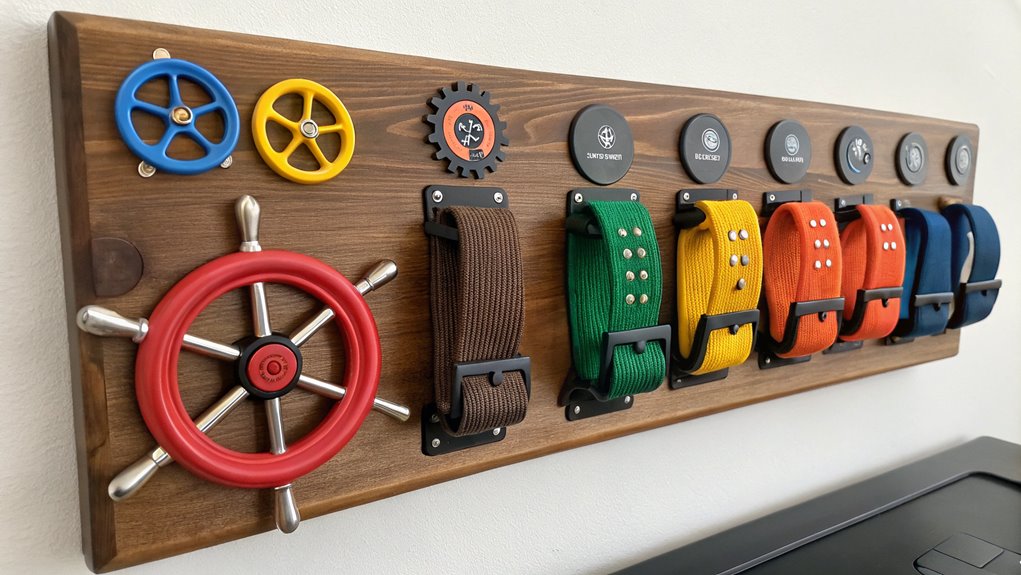
Transportation themed panels shift focus from auditory exploration to imaginative play through interactive vehicle elements. Add steering wheels, gear shifts, and miniature transportation vehicles that your little one can move along tracks or roads. Create simple travel destinations like a gas station or airport terminal using painted wooden elements. Your child will love pretending to journey to exciting places!
Kitchen Tools Display
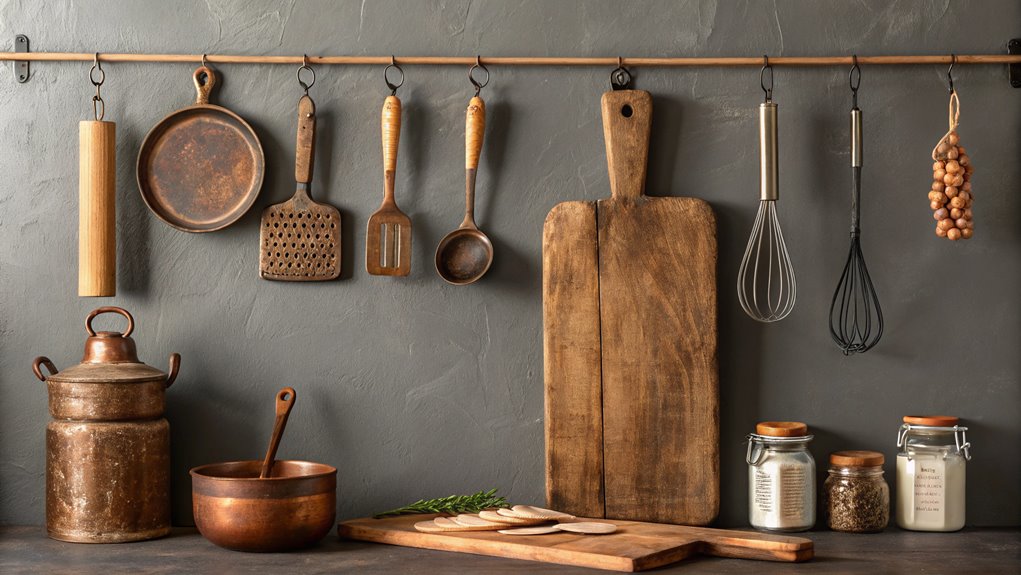
A kitchen tools display brings familiar household items into your child’s play space while teaching valuable sensory and motor skills. You can attach safe kitchen utensils like plastic measuring spoons, wooden spatulas, and whisks to create engaging activities. Remember to choose items that promote cooking safety awareness – avoid sharp objects and secure all pieces firmly to prevent any hazards.
Numbers and Letters Board
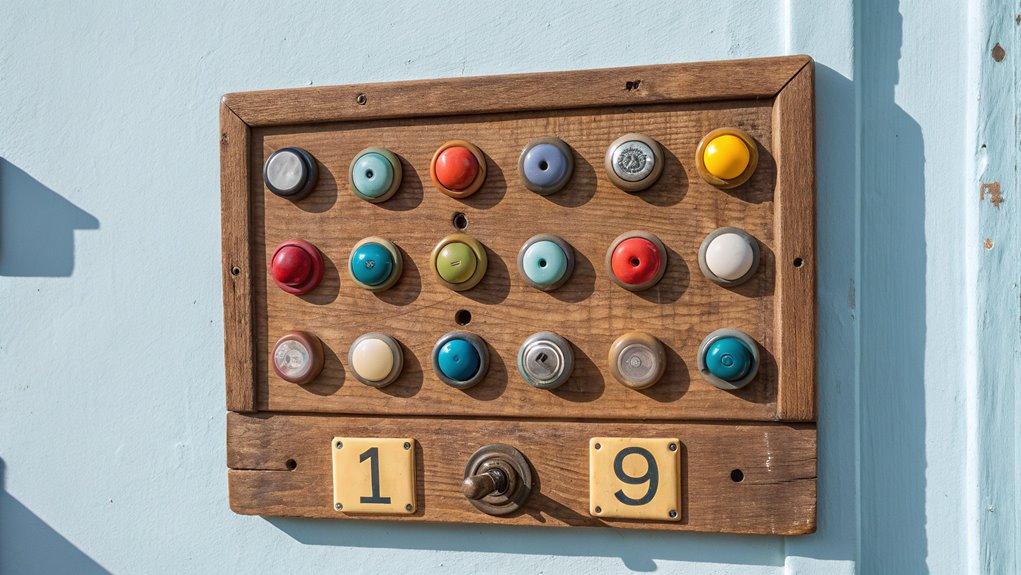
Teaching fundamental literacy and numeracy becomes engaging with a dedicated numbers and letters board section. You can create fun activities by adding magnetic numbers and letters that kids can arrange and rearrange. Include textured materials for letter tracing practice, and add colorful number recognition games. Make learning interactive by incorporating sliding elements and matching activities that keep young minds excited.
Sensory Textures Panel
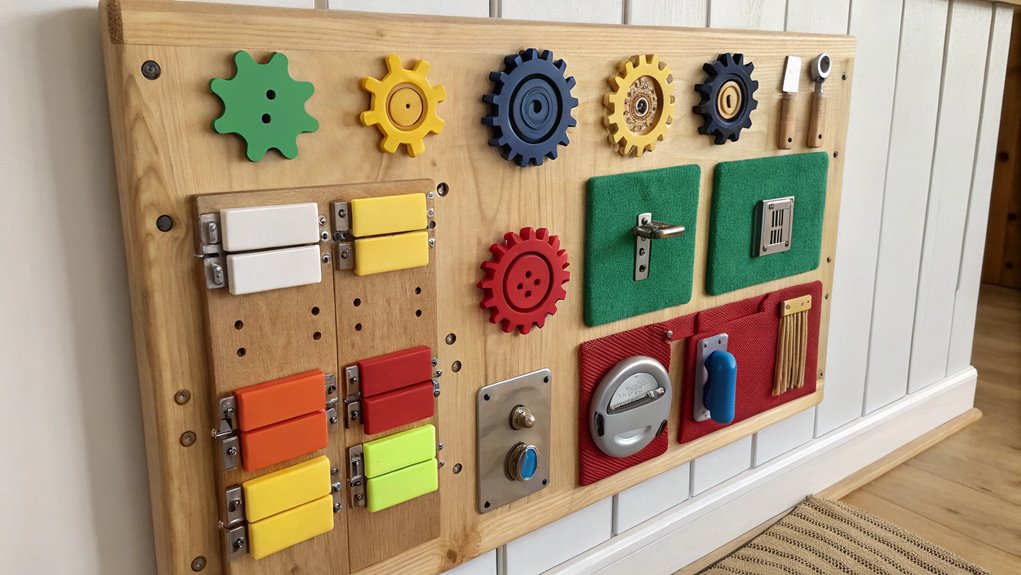
Exploring different textures through touch is essential for developing a child’s sensory awareness and fine motor skills. Create an engaging panel by attaching various materials like soft felt, rough sandpaper, smooth satin, and bumpy corduroy. This tactile exploration encourages sensory play while keeping little hands busy. You can also add zippers, buttons, and velcro strips for extra interactive elements.
Farm Animals Interactive Board
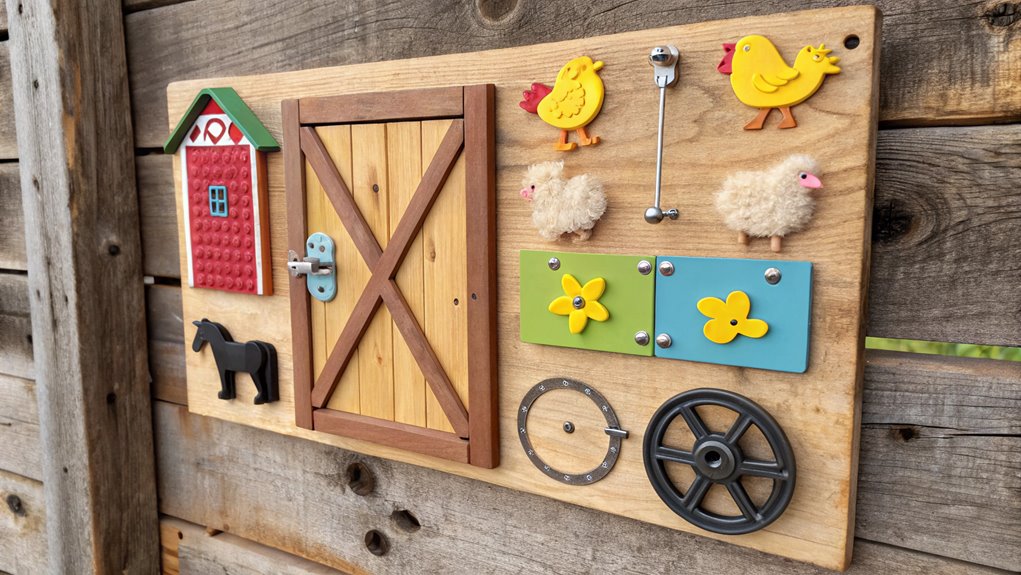
Young children adore farm animals, making this themed interactive board an excellent choice for both entertainment and education. Create interactive elements like lift-the-flap barn doors, sliding chickens, and pull-tabs that trigger farm animal sounds. Add different barnyard textures like fuzzy sheep wool, smooth egg shapes, and rough hay patches to enhance sensory exploration and learning.
Colorful Shapes Board
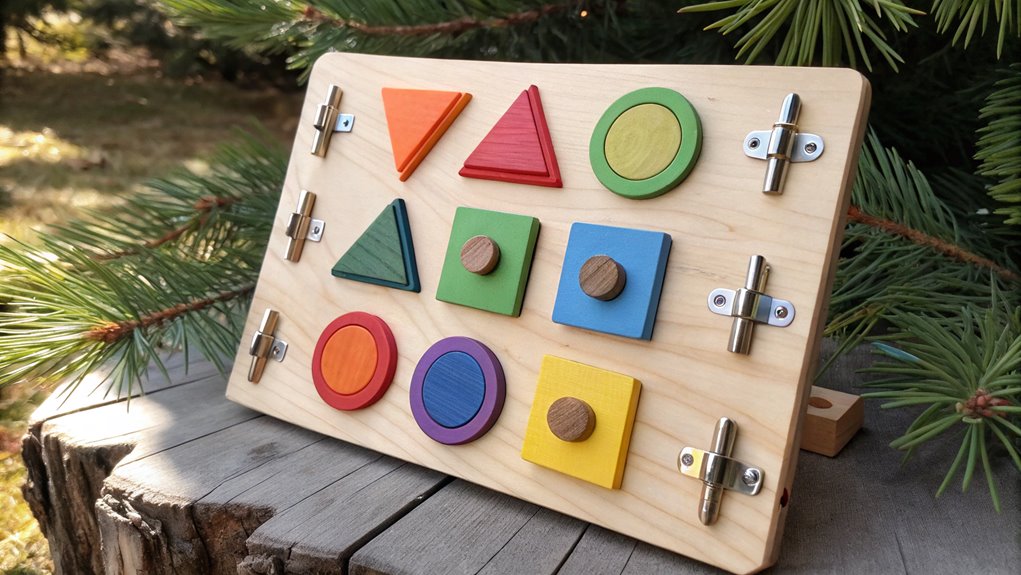
While farm animals captivate toddlers, geometric shapes and vibrant colors form another fundamental building block of early childhood development. Create a board filled with different shapes in bold colors that your little one can match and sort. This hands-on activity enhances color recognition and shape sorting skills while keeping your child engaged in playful learning.
Household Items Display
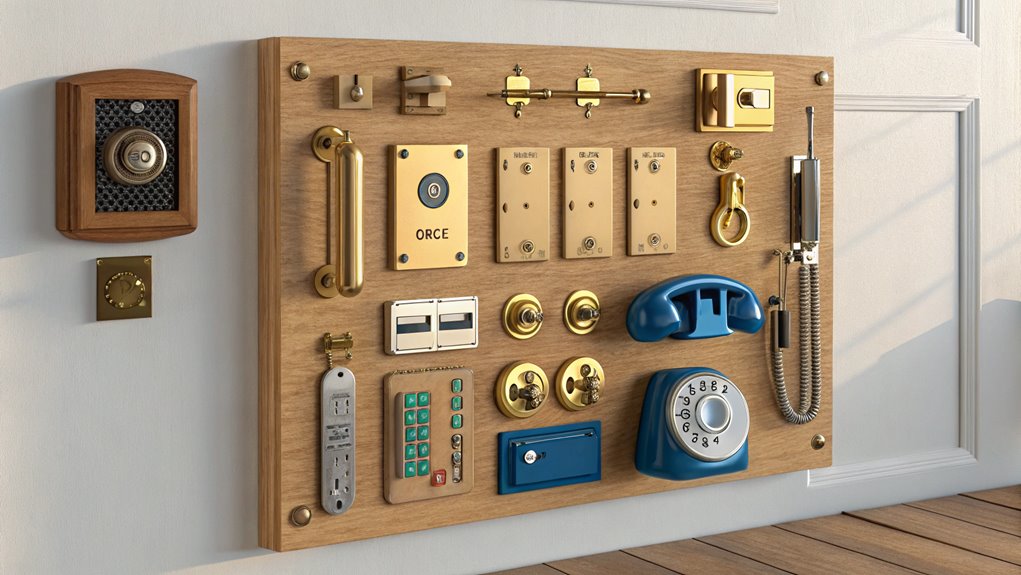
From kitchen utensils to bathroom accessories, everyday household items make excellent additions to a busy board, offering familiar objects that children encounter in their daily lives. You can enhance learning through household organization by grouping similar items together. Try adding safe versions of door locks, light switches, and zippers. This item categorization helps kids understand their environment while having fun.
Recycled Materials Board
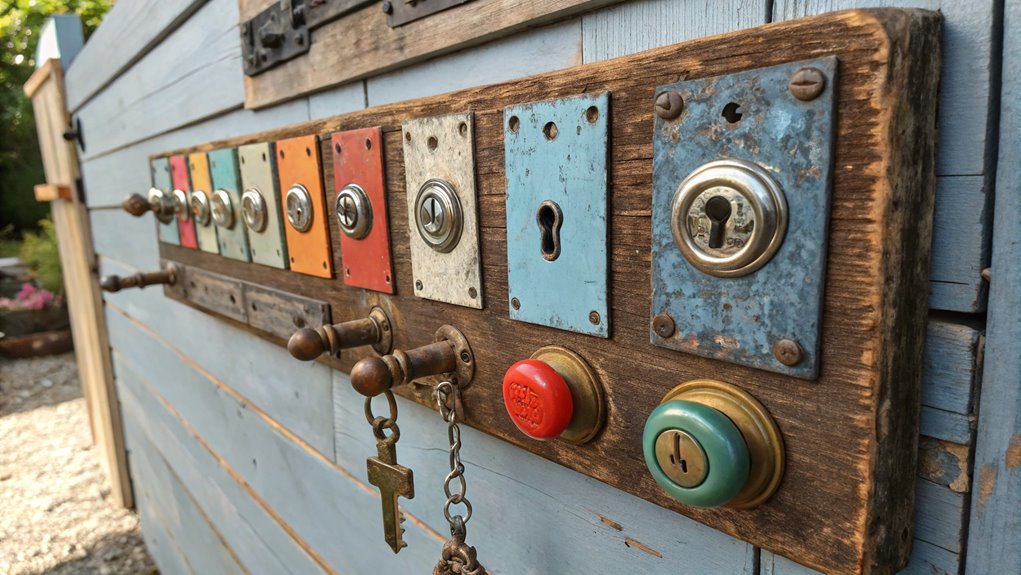
Creating a busy board from recycled materials offers both environmental and economic benefits while maintaining the same engaging qualities as store-bought components. You can incorporate recycled toys like old puzzle pieces, bottle caps, and unused game pieces into your design. By embracing eco-friendly practices, you’ll not only save money but also teach children about sustainability through creative play.
Beach Theme Sensory Station
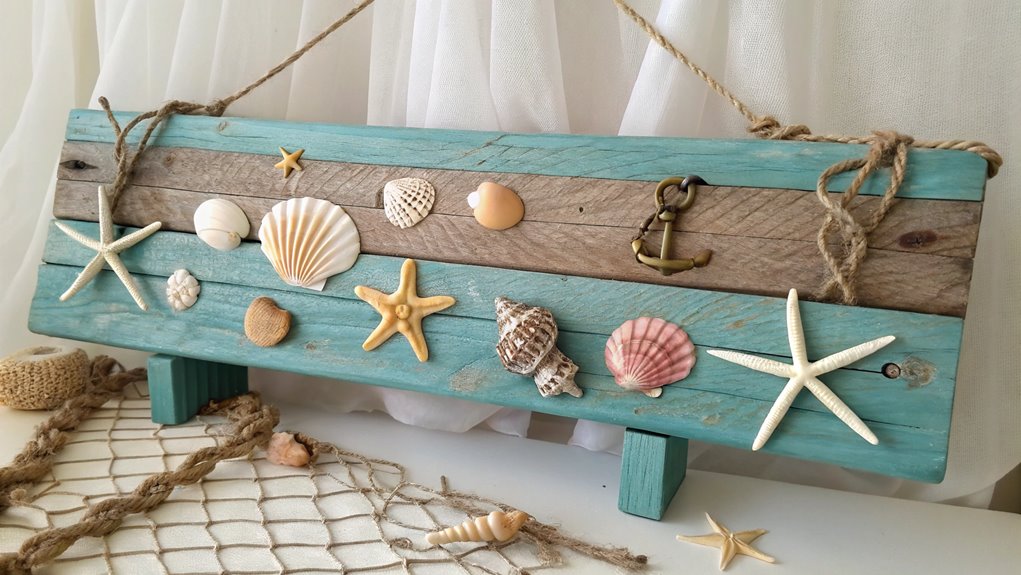
A beach-themed sensory station transforms an ordinary busy board into a coastal learning adventure. Create an engaging beach sensory experience by adding seashells, smooth stones, and textured sand patches. You can include rope knots for fine motor skills and blue fabric waves for ocean exploration. Add small boats, wooden fish, and a lighthouse to complete your seaside scene.
Seasonal Activities Panel
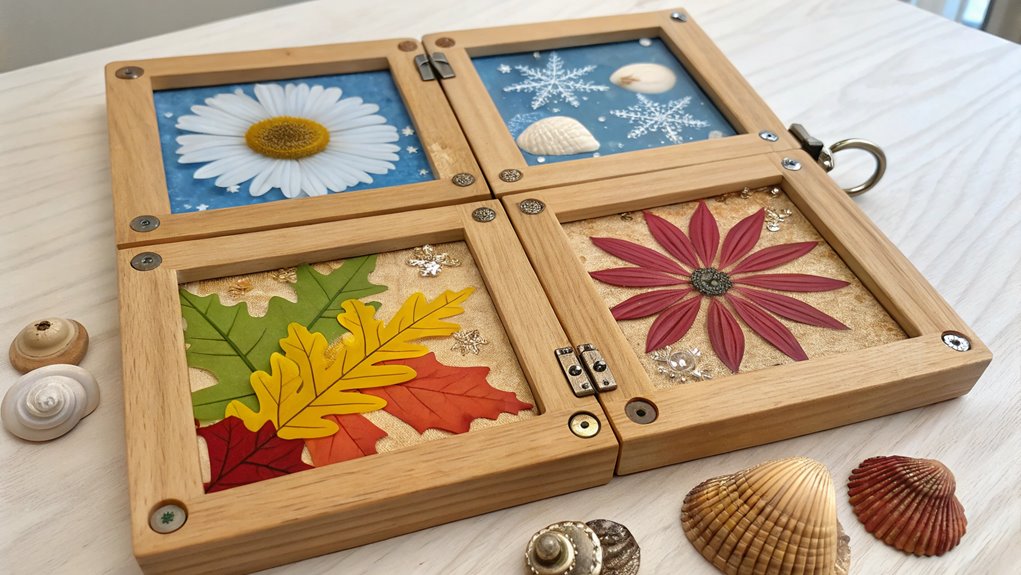
Through rotating seasonal activities, a dedicated panel on your busy board keeps children engaged year-round while teaching them about nature’s cycles. You can create interchangeable seasonal crafts like felt leaves for fall, snowflakes for winter, and flowers for spring. Add holiday decorations that children can attach and remove, helping them understand the passage of time while developing fine motor skills.
Woodland Creatures Board
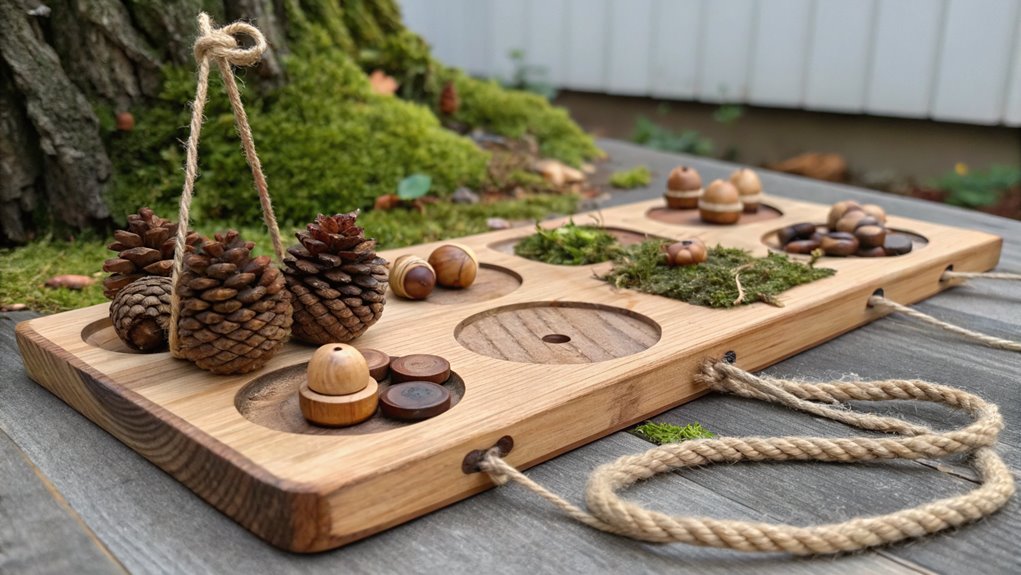
Transform your busy board into an enchanting forest adventure with a woodland creatures theme that captivates young minds. Create interactive woodland adventures by adding peek-a-boo doors revealing hidden forest animals, spinning owl wheels, and sliding fox puzzles. Include soft-touch fabric squirrels, pull-string birds, and a hedgehog with moveable felt spikes that your little one can manipulate.
Moving Parts Workshop
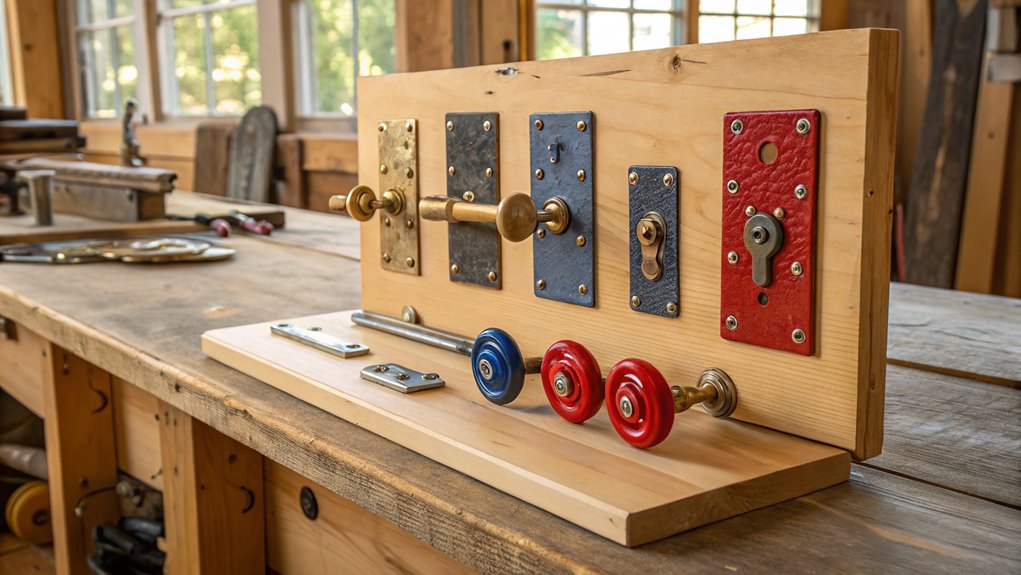
Every successful busy board incorporates engaging moving parts that challenge and delight young children. When designing your board, mix creative mechanisms like latches, wheels, and sliders to keep little hands busy. You can add hinged doors, spinning dials, and pull cords that develop fine motor skills. These interactive elements make learning fun while encouraging problem-solving and exploration.
Weather Learning Board
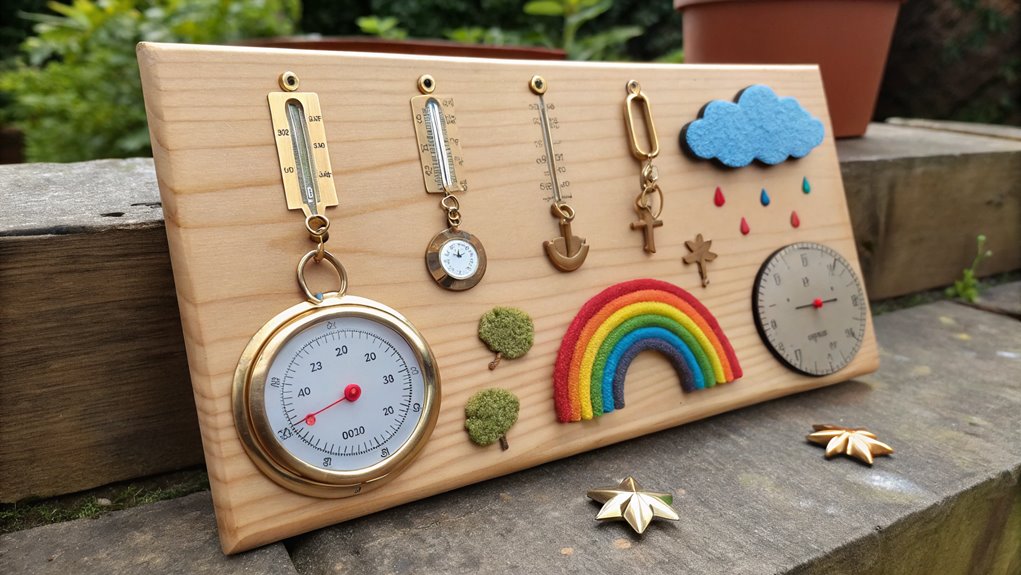
Building on the concept of interactive learning, a weather-themed busy board offers children a hands-on way to understand daily meteorological changes. You can create movable weather symbols that kids can switch around to match the day’s conditions. Include fun climate activities like a spinning temperature wheel, sliding rain gauge, and movable cloud shapes that allow young learners to become mini meteorologists.
Office Supplies Panel
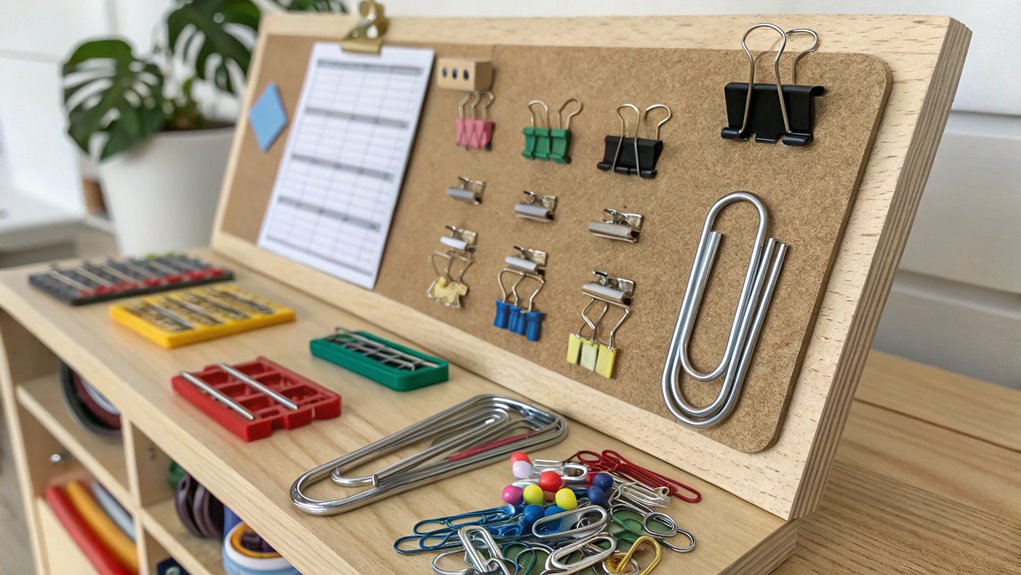
Modern office supplies provide endless possibilities for creating an engaging busy board section that develops fine motor skills. You can add a child-safe stapler fun zone where kids practice pressing and securing papers. Include colorful paper clips for sorting and linking activities. These common office items offer safe ways to build dexterity while introducing children to everyday tools.
Construction Theme Board
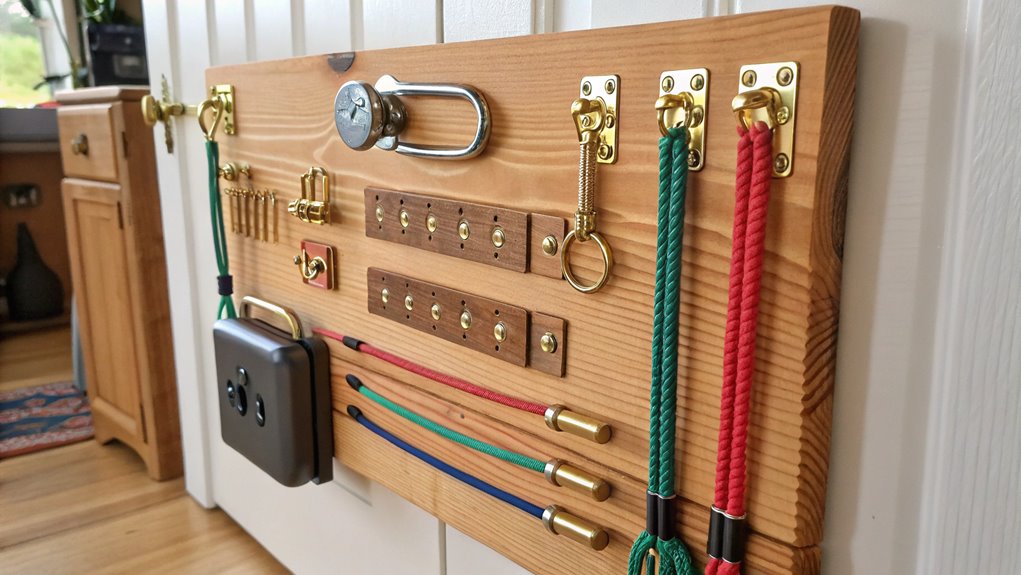
A construction-themed busy board captivates young minds while teaching essential coordination skills through simulated building site elements. You can add miniature building blocks, a toy crane handle, and small wheels that turn. Create a realistic construction site experience by including a sliding metal ruler, nuts and bolts to twist, and a level that moves back and forth.
Sports Equipment Display
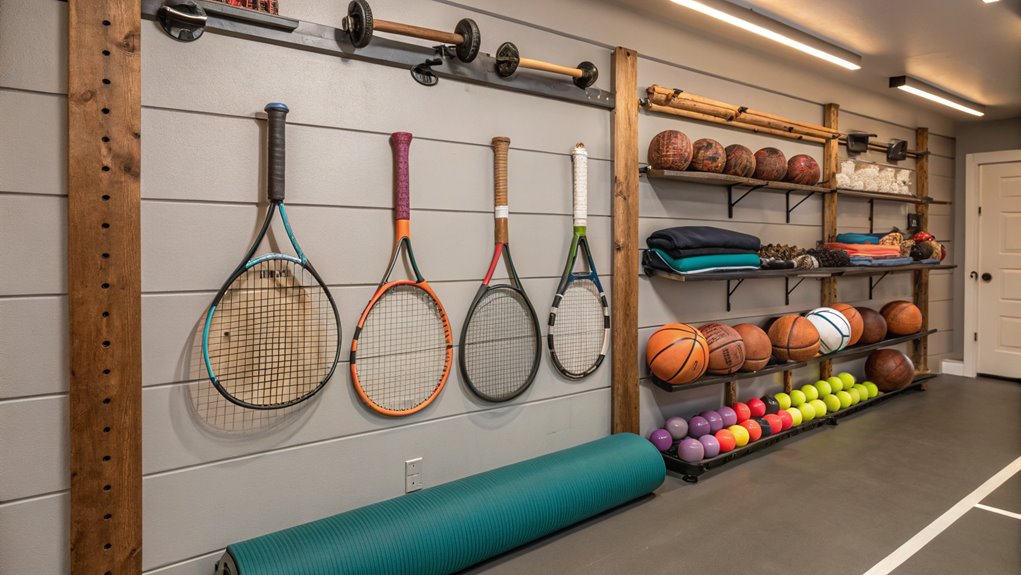
From construction sites to sports fields, energetic toddlers can further develop their motor skills through an interactive sports equipment display board. Create an engaging athletic gear showcase by mounting miniature versions of sports items like baseball mitts, tennis rackets, and basketball hoops. This sports equipment organization system lets little ones practice gripping, throwing, and coordinating movements in a safe, controlled setting.
Garden Tools Board
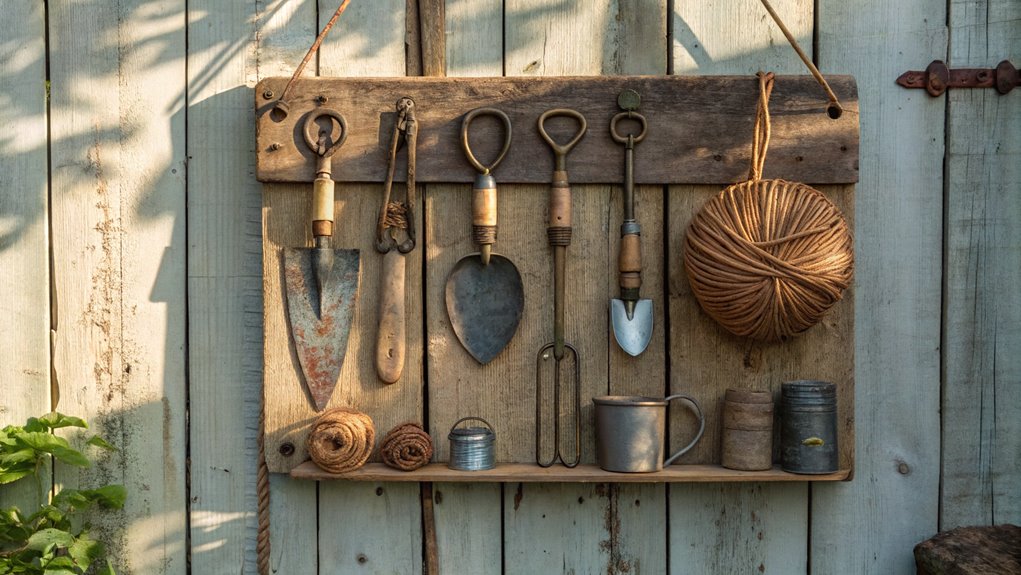
Little gardeners can explore their green thumbs safely with a garden tools-themed busy board that brings the outdoors inside. You can mount plastic trowels, rubber watering cans, and soft-bristled brushes to teach garden tool safety while keeping your child engaged. This hands-on activity introduces basic gardening benefits like motor skills development and nature appreciation in a controlled environment.
Frequently Asked Questions
What Age Is Appropriate to Start Using a Busy Board?
Busy boards are typically suitable for babies around 6-12 months old, when they begin reaching key developmental milestones like grasping objects and engaging in sensory exploration. However, you can introduce simplified versions to babies as young as 4 months who show interest in touching and manipulating items. Just remember to always supervise playtime and make sure all components are securely attached and age-appropriate for safety.
How Do I Safely Seal or Treat Wood for a Busy Board?
For safe wood sealing techniques on children’s items, start with thorough sanding to prevent splinters. Apply non-toxic, child-safe finishes like food-grade mineral oil, beeswax, or water-based polyurethane specifically labeled as child-safe. Allow plenty of drying time between coats, and guarantee proper ventilation during application. Natural oils need reapplication every few months, while polyurethane provides longer-lasting protection. Always test finishes on a small area first.
How Often Should Busy Board Components Be Checked for Safety?
Regular safety inspections of your busy board should become part of your routine. Check all components at least monthly, focusing on loose parts, sharp edges, and wear and tear. Before each use, do a quick visual scan and wiggle test of all items. If your little one is particularly active with the board, increase your maintenance checks to weekly. Remember, busy board maintenance is essential for preventing accidents and ensuring lasting fun.
Can Busy Boards Be Used for Special Needs Children?
Like a key that opens endless possibilities, busy boards can be wonderful learning tools for children with special needs. They’re particularly effective for sensory integration, allowing kids to explore different textures, movements, and sounds at their own pace. The hands-on nature of busy boards supports cognitive development through play, helping children develop fine motor skills and problem-solving abilities in a safe, engaging way that matches their individual needs.
What Dimensions Are Recommended for Different Age Groups?
For toddlers (1-3 years), recommended dimensions are 16×20 inches, keeping it manageable and safe. Preschoolers (3-5 years) can handle 20×24 inches, allowing more activities. School-age children (5-8 years) work well with 24×36 inches for age-specific designs and complex features. For special needs children, consider their individual abilities rather than age, but start with smaller dimensions around 16×20 inches to prevent overwhelming them.
